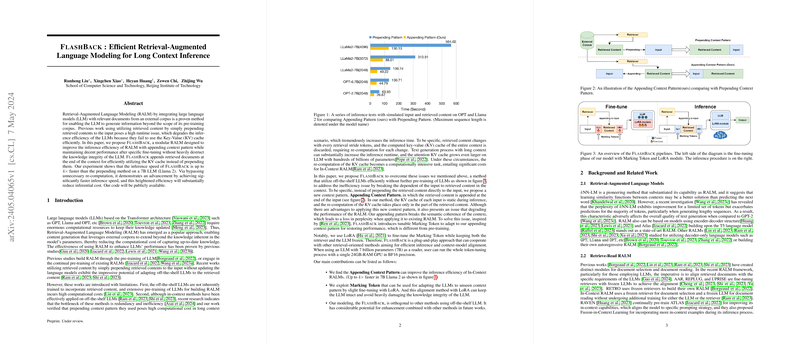Exploring FlashBack: Enhancing Inference Efficiency in Retrieval-Augmented LLMs
Introduction to Retrieval-Augmented LLMing (RALM)
Retrieval-Augmented LLMing has become a staple approach for integrating external knowledge into LLMs like GPT or Llama. By leveraging additional documents during the generation process, these models can surpass the limitations of their initial training data. Traditional implementations often prepend these documents directly to the model's input, but this introduces high computational costs and inefficiencies during inference, particularly when the model context is lengthy.
Introducing FlashBack
FlashBack proposes an elegant solution to the inefficiencies observed in current RALMs by flipping the script—literally. Instead of prepending, FlashBack appends retrieved documents at the end of the context. This novel approach, termed the Appending Context Pattern, significantly reduces the need to recompute the key-value cache during inference, thereby slashing computational overhead and speeding up the processing time by up to four times in certain models, as demonstrated in a 7 billion parameter Llama 2 model.
The Mechanism Behind FlashBack
Efficient Key-Value Caching
At its core, the improvement in efficiency with FlashBack stems from its innovative use of key-value (KV) pair caching. In traditional models, every new piece of retrieved content forces a recalculation of the entire cache. FlashBack, by appending new data, keeps prior KV pairs intact, leveraging them for subsequent computations and minimizing the frequency of cache refreshes.
Adapting to New Context Patterns
A possible drawback of appending content could be a drop in the model's performance due to the disrupted flow of information. FlashBack addresses this by introducing Marking Tokens that signal the boundaries of the appended content, helping the model understand and adapt to the new structure. These tokens, fine-tuned with a technique called Low-Rank Adaptation (LoRA), allow FlashBack to maintain, and sometimes even enhance, the LLM's performance without extensive retraining.
Practical Implications and Theoretical Contributions
FlashBack not only demonstrates a considerable reduction in runtime but also opens new doors for the practical deployment of RALMs in systems where computational resources are at a premium. The ability to integrate external knowledge efficiently without compromising performance could significantly enhance the utility of LLMs in real-world applications.
From a theoretical standpoint, the success of the Appending Context Pattern challenges existing norms about how context should be integrated into LLMs and may prompt further investigations into alternative methods of information integration in neural architectures.
Future Directions
While FlashBack has shown promising results, there persists an avenue for exploration, particularly in the realms of multi-document retrieval and real-time learning. How might the appending strategy handle dynamically changing datasets or real-time streaming inputs? Additionally, while the appending context pattern proves efficient, its full potential when scaled or adapted to different model architectures or more complex datasets remains to be thoroughly vetted.
Conclusion
In summary, FlashBack not only refines the inference process for retrieval-augmented models but also maintains robust performance metrics, presenting a compelling case for rethinking how external information is integrated into neural LLMs. Its modular design coupled with low computational overhead makes it a strong candidate for future development and integration into various AI applications, potentially setting a new standard for efficient LLM design.
